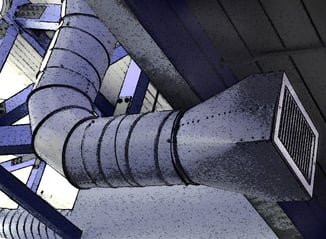 Combustible dust collected in visible areas or accumulating on high surfaces is a well-known source of industrial fires and explosions. It’s usually when an employee or inspector notices the dust levels on these surfaces is higher than what code allows that we get called to come out and safely clean it for our customers. However, there is one area that is often overlooked when it comes to combustible dust hazards: the ductwork.
Combustible dust collected in visible areas or accumulating on high surfaces is a well-known source of industrial fires and explosions. It’s usually when an employee or inspector notices the dust levels on these surfaces is higher than what code allows that we get called to come out and safely clean it for our customers. However, there is one area that is often overlooked when it comes to combustible dust hazards: the ductwork.
Dust can stay in the air for days, depending on its size, and over time will be brought into the ventilation ductwork as air flows through the building. The dust will begin to settle in sections of the ventilation where there is a bend or protrusion, or anything else that might begin to snag the dust flowing past. This can lead to significant accumulations of potentially explosive dust, even if the rest of the building appears clean and safe.
This may seem like it’s not an issue, the ducts are covered and should be safe from ignition sources, right? Wrong, and in fact the flowing air actually causes potential ignition sources to be drawn into the ductwork. Sparks and embers can stay hot for a long enough time to be sucked into the HVAC system and come into contact with the dust, or a piece of metal travelling through the ductwork can scrape the side and create an ignition spark. The dust moving through the ventilation also creates a buildup of static electricity, which can have the potential to create an explosion.
One of the sections of the Duct Explosion Pentagon is ‘confinement’, and if there is dust and an ignition source in the ductwork it creates the perfect combination for a dust explosion. The pressure builds with the initial explosion, and the confinement forces the flames to travel down the ductwork, consuming the collected dust along the way. It acts much like the barrel of a gun or cannon, and builds up immense pressure until it hits something that blocks it, where it then exerts the pressure to force through the weakest point. This is where the explosion becomes dangerous to employees, because the force of these dust explosions can blow entire roofs off buildings or buckle concrete floors, or throw heavy machinery through a building.
Where is the weakest point in your ductwork? Is there a vent near you? What would happen if an explosion suddenly blew out of the vent nearest you?
Do you need help cleaning the combustible dust in ductwork?
Contact a Hughes Environmental representative to learn how we can help you avoid fire & explosion hazards in the workplace.

